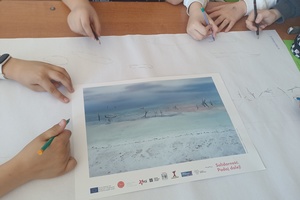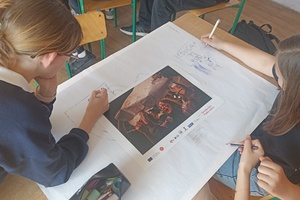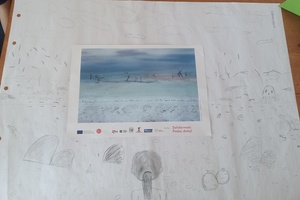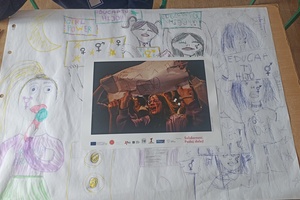Education through image reading

In the ever-evolving landscape of education, the integration of visual elements has emerged as a powerful tool to enhance learning experiences. Image reading plays a crucial role in promoting anti-discrimination education. Visual representations of diverse cultures, lifestyles, and histories can break down prejudices and foster empathy. By encountering and interpreting images that depict various racial, ethnic, and social groups, students can develop a deeper understanding and appreciation for diversity. This visual engagement helps challenge stereotypes and encourages inclusivity and respect for all individuals.
Images capture attention and stimulate interest, making learning more engaging. This is particularly important in maintaining the attention of younger learners and those with shorter attention spans.
Visual learning supports students with different learning needs, including those with learning disabilities. It provides alternative ways to process and understand information, ensuring inclusivity in education.
TIPS FOR WORKING WITH PHOTOGRAPHS DURING THE LESSON
Define the purpose of the lesson. What do you want your students to leave the lesson with (skills, attitudes, reflections)? Consider how photography can help you do this.
Choose a photograph that is close to you, that arouses emotions in you - if you are involved in analyzing it, your students will be more likely to take an interest in it.
Before class, think about the exercises you choose - how you want to use the photographs. Will the photo analysis exercise be the main method of work during the lesson, or one of many? Think about how you will introduce the photo during class (you will display it on the screen, hand out printed copies, show only a section of it and you and your students will explore the whole picture piece by piece).
Think through the context of the photograph. When do you want to share it with the class? Encourage students to see the photo first and discuss it without knowing its context, as this strengthens critical thinking skills in them.
When discussing the photos, different emotions may arise. Take care that students and students speak respectfully, including towards the people depicted in the photographs. Emphasize that these are real people who deserve it, even if we don't don't know them.
Emphasize that a photo is a fragment of reality. Photography is an imitation of the world – may be close, but it will never be complete. In its analysis, there are no right or wrong answers. Students can give different interpretations of what they see. The exercise is not about guessing the context, fitting into a key. It serves to reflect on what we see and the emotions involved, and to talk about important issues that move us.
It may happen that the statements of your students go in the direction of interpretations that seem unlikely. Don't deny them, don't try to tip them off. Ask if this situation/story could have a different explanation, a different course, could it look different. Maybe someone has an idea? Ask people to justify their interpretations and opinions based on the photograph. You can, for example, ask questions: "On what basis do you think so?", "What made you think so?". Analysis is about discussion, about confronting your beliefs and justifying them. Follow your class, see where it leads you.
Take care to distinguish between what we see and what we know/think. Ask students if they think they see something, or if they actually see it. E.g.: two people in a photograph, one is crying, the other is sitting with her back turned to her. Did these people argue? On what basis do we assume so? Do we think so, or do we see it? Emphasize that we only see the person crying and the person with his back turned. The relationship between them and the situation is only our assumption - it didn't have to really happen.
Emphasize that framing the photo can change the way it is read. Ask students which part of the photograph under discussion they would choose to cut out to make it take on a different meaning. You can play around with several photographs in this way. Point out that the photographs we see in the media and on the Internet have been cropped by someone (intentionally or accidentally) and it's important that we don't draw too hasty conclusions about them.
It may happen that the statements of your students go in the direction of interpretations that seem unlikely. Don't deny them, don't try to tip them off. Ask if this situation/story could have a different explanation, a different course, could it look different. Maybe someone has an idea? Ask people to justify their interpretations and opinions based on the photograph. You can, for example, ask questions: "On what basis do you think so?", "What made you think so?". Analysis is about discussion, about confronting your beliefs and justifying them. Follow your class, see where it leads you.
Take care to distinguish between what we see and what we know/think. Ask students if they think they see something, or if they actually see it. E.g.: two people in a photograph, one is crying, the other is sitting with her back turned to her. Did these people argue? On what basis do we assume so? Do we think so, or do we see it? Emphasize that we only see the person crying and the person with his back turned. The relationship between them and the situation is only our assumption - it didn't have to really happen.
Emphasize that framing the photo can change the way it is read. Ask students which part of the photograph under discussion they would choose to cut out to make it take on a different meaning. You can play around with several photographs in this way. Point out that the photographs we see in the media and on the Internet have been cropped by someone (intentionally or accidentally) and it's important that we don't draw too hasty conclusions about them.
It may happen that the statements of your students go in the direction of interpretations that seem unlikely. Don't deny them, don't try to tip them off. Ask if this situation/story could have a different explanation, a different course, could it look different. Maybe someone has an idea? Ask people to justify their interpretations and opinions based on the photograph. You can, for example, ask questions: "On what basis do you think so?", "What made you think so?". Analysis is about discussion, about confronting your beliefs and justifying them. Follow your class, see where it leads you.
Take care to distinguish between what we see and what we know/think. Ask students if they think they see something, or if they actually see it. E.g.: two people in a photograph, one is crying, the other is sitting with her back turned to her. Did these people argue? On what basis do we assume so? Do we think so, or do we see it? Emphasize that we only see the person crying and the person with his back turned. The relationship between them and the situation is only our assumption - it didn't have to really happen.
Emphasize that framing the photo can change the way it is read. Ask students which part of the photograph under discussion they would choose to cut out to make it take on a different meaning. You can play around with several photographs in this way. Point out that the photographs we see in the media and on the Internet have been cropped by someone (intentionally or accidentally) and it's important that we don't draw too hasty conclusions about them.


